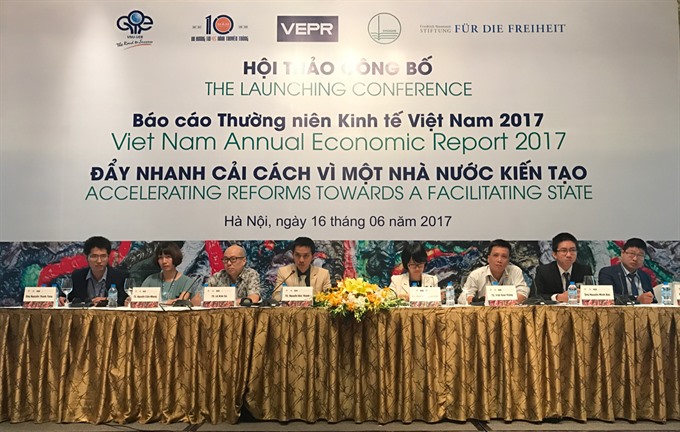 Economy
Economy

A conference to launch the Việt Nam Annual Economic Report 2017 was held in Hà Nội on Friday, discussing institutional reforms.
 |
| The guest speakers of “Việt Nam Annual Economic Report 2017” launch conference. — VNS Photo Phương Thảo |
HÀ NỘI — A conference to launch the Việt Nam Annual Economic Report 2017 was held in Hà Nội on Friday, discussing institutional reforms.
The report, entitled “Accelerating reforms towards a facilitating State”, is launched in the context of Viet Nam’s economic growth easing and productivity slowly improving.
The Party Central Committee has approved resolutions to improve market economy institutions and set targets including institutional reform, improving the business environment and creating favourable conditions for enterprises.
Investors were closely watching political moves and the ability of the Government to realise its commitment to building a transparent and facilitating government, said Nguyễn Đức Thành, president of Việt Nam Institute for Economic and Policy Research (VEPR).
The report assesses Việt Nam economy in 2016 and analyses factors in institutional reform for a facilitating State.
The term “facilitating government" means a government that ensures fundamental rights and rule of law so that society can operate in the most effective way. "In that sense, a facilitating government recreates itself and society by retreating from its constructivist past," Thành added.
The research group also proposed ideas for institutional reforms including defining in law the relationship among the Party, State and society, building a professional judiciary independent from other parts of state power, recruiting more technocrats into administration, reducing State bureaucracy and State intervention in the market, boosting civilian participation in developing society and enhancing the State’s accountability.
The report also highlights the growing middle class and shifting policies in Việt Nam, which demonstrates that the development of Việt Nam’s middle class is mainly due to the labour shifting from rural to urban areas and from agricultural to non-agricultural and formal sectors.
The last chapter of the report provides two scenarios for Việt Nam’s macroeconomic prospects in 2017 and details current short–term policies.
Forecasts show that growth of 6.7 per cent can be achieved, but this raises the question of whether the growth is sustainable. In this scenario, 2017 inflation is forecast at 3.2 per cent. In a scenario of more natural economic growth, the growth rate is about 6.37 per cent and the yearly inflation is low at 2.35 per cent.
Cấn Văn Lực, director of BIDV Training School, suggested that the Việt Nam’s economy should focus on developing consumption, which accounted for 75 per cent of GDP last year.
Tourism is also a driven factor for the domestic economy through its contribution of VNĐ400 trillion (US$17.6 billion) in 2016, accounting for 6.8 per cent of the country’s GDP.
The State could concentrate on boosting tourism instead of exploiting oil to achieve the target of 6.7 per cent in growth, Lực said.
Việt Nam Annual Economic Report, published by VEPR, is a series of annual reports summarising major economic issues in the previous year, giving an economic outlook for the coming year and providing policy recommendations.
The conference was organised by VEPR and the Friedrich Naumann Foundation Việt Nam. — VNS